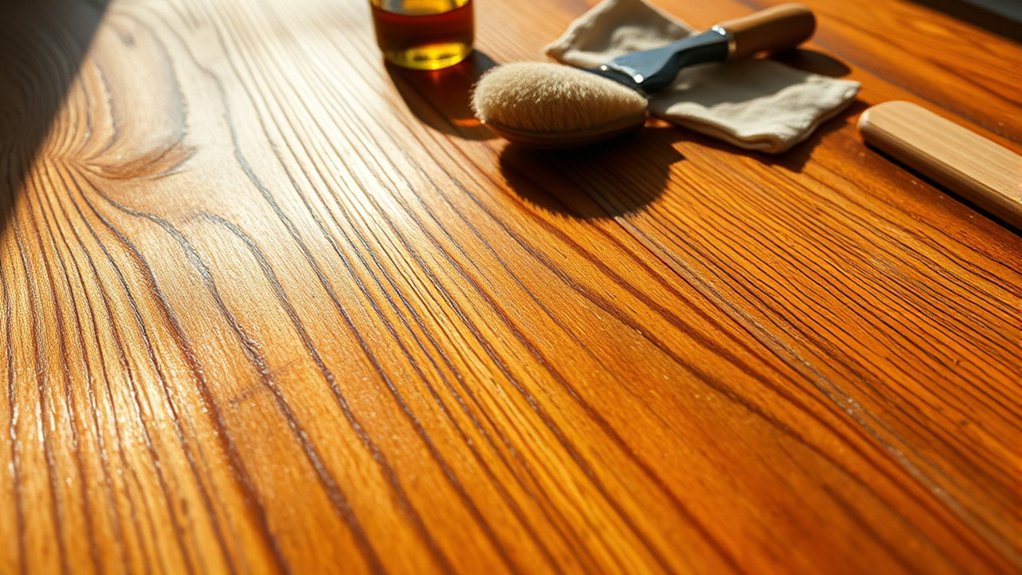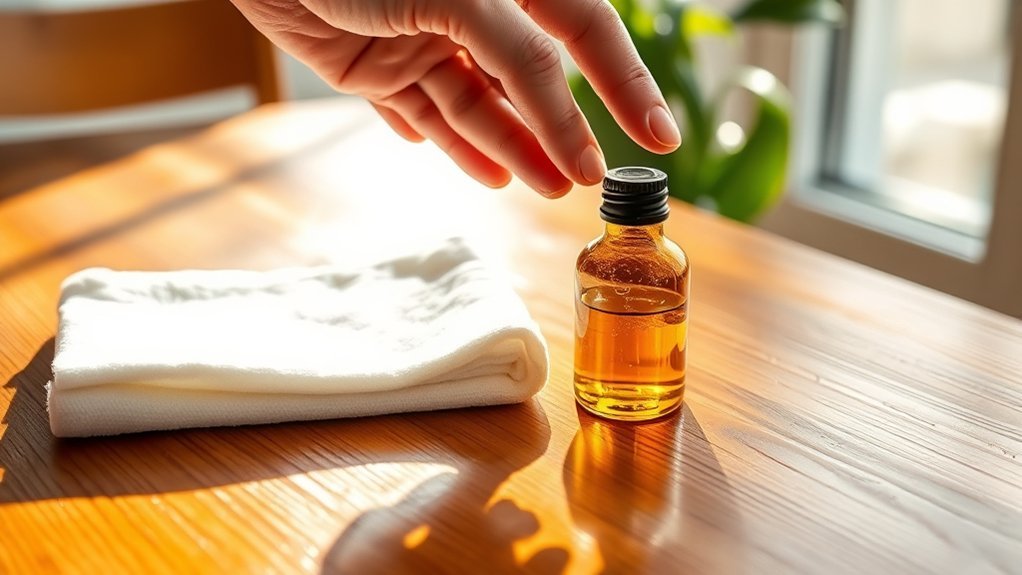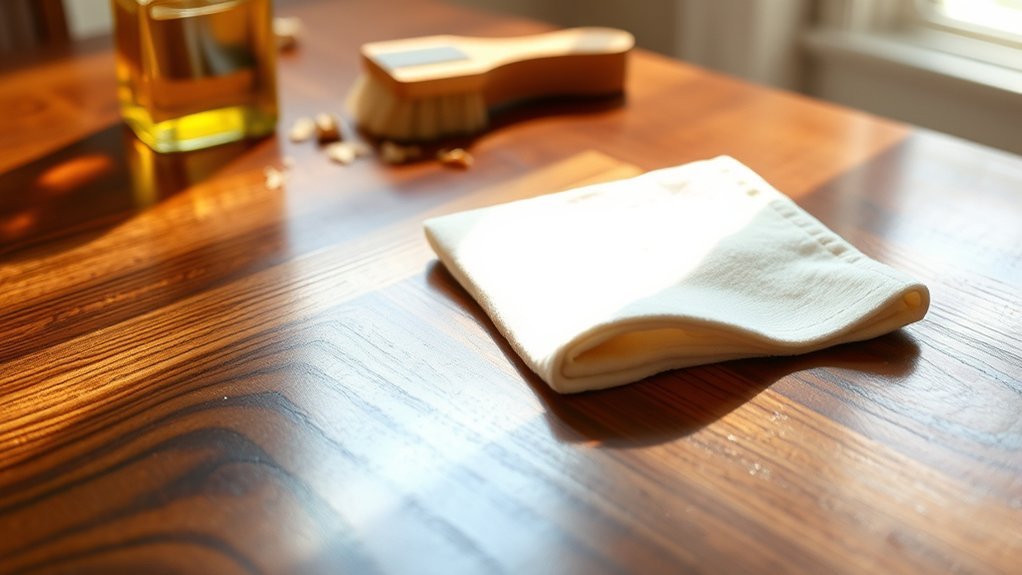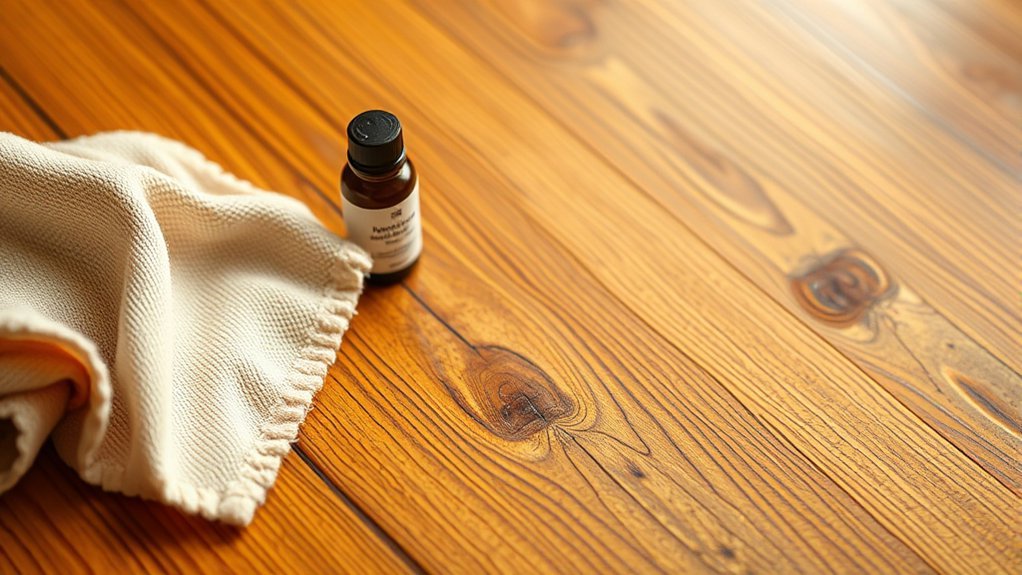Proper wood stock care and maintenance are vital for the durability of your wooden items. You’ll want to dust surfaces regularly and clean them with a damp cloth and mild soap to prevent moisture damage. High-quality finishes can shield your wood from environmental factors. However, understanding how to store and inspect your wood can make all the difference in its longevity. Let’s explore these essential practices further to guarantee your wood remains in top condition.
Understanding the Importance of Wood Care

When you understand the importance of wood care, you can greatly extend the lifespan of your wooden items. Proper maintenance prevents moisture damage, which causes warping and cracking. Regularly checking for signs of wear helps you catch potential issues early. You should also be mindful of temperature and humidity, as fluctuations can lead to deterioration. Applying protective finishes, such as varnish or oil, creates a barrier against environmental factors. Additionally, using coasters and mats can protect surfaces from scratches and heat. Ensuring proper storage is vital; keep wooden items in a controlled environment, away from direct sunlight and excessive moisture. By prioritizing wood care, you not only preserve the beauty of your items but also their structural integrity.
Cleaning Techniques for Wooden Surfaces

Maintaining the beauty and integrity of wooden surfaces starts with effective cleaning techniques. First, always dust your wooden surfaces with a soft, lint-free cloth to remove dirt and debris. For deeper cleaning, use a damp cloth with a mild soap solution, ensuring you don’t saturate the wood.
| Cleaning Method | Recommended Frequency | Special Considerations |
|---|---|---|
| Dusting | Weekly | Use a microfiber cloth |
| Damp Cleaning | Monthly | Avoid excessive moisture |
| Spot Cleaning | As needed | Use a gentle cleaner |
After cleaning, dry the surface immediately to prevent water damage. Adopting these techniques will help preserve your wooden surfaces and extend their life.
Polishing and Finishing Your Wood Furniture

To achieve a stunning finish on your wood furniture, start by selecting the right polish that complements the type of wood and desired sheen. Apply the polish using a soft cloth in the direction of the grain, ensuring even coverage without over-saturating the surface. Finally, maintain the longevity of your finish by regularly dusting and reapplying polish as needed to protect against wear and damage.
Choosing the Right Polish
Choosing the right polish for your wood furniture can markedly enhance its appearance and longevity. Selecting the appropriate product requires careful consideration of your wood type and desired finish. Here are four key factors to guide your choice:
- Wood Type: Identify whether your furniture is made from hardwood or softwood, as some polishes suit specific types better.
- Finish Compatibility: Verify the polish complements your existing finish, whether it’s lacquer, oil, or varnish.
- Sheen Level: Decide on the desired sheen—matte, satin, or glossy—based on your aesthetic preference.
- Ingredients: Opt for natural ingredients over synthetic ones to maintain the wood’s health and avoid chemical damage.
Application Techniques Explained
Polishing and finishing your wood furniture requires a methodical approach to achieve a beautiful, durable result. Start by thoroughly cleaning the surface with a soft cloth to remove dust and grime. Next, apply your chosen polish using a clean, lint-free cloth. Work in small sections, using circular motions to evenly distribute the product. Allow the polish to penetrate for a few minutes before buffing it with a separate clean cloth, enhancing the shine. For finishes, use a high-quality varnish or lacquer. Apply thin coats with a foam brush, allowing each layer to dry completely before adding the next. Sand lightly between coats for a smooth finish. Always follow the manufacturer’s instructions for best results.
Maintaining Finish Longevity
After achieving a polished finish on your wood furniture, maintaining that shine and protection requires regular care and attention. Follow these steps to prolong your finish’s longevity:
- Dust Regularly: Use a soft, lint-free cloth to remove dust and debris, preventing scratches.
- Avoid Direct Sunlight: Position your furniture away from direct sunlight to prevent fading and damage.
- Use Appropriate Cleaners: Opt for pH-balanced cleaners designed for wood; harsh chemicals can strip the finish.
- Reapply Polish: Every few months, apply a quality wood polish to restore luster and create a protective barrier.
Protecting Wood From Moisture Damage
To protect wood from moisture damage, it is crucial to understand how water affects its integrity. When wood absorbs moisture, it can swell, warp, or even develop mold. Start by sealing your wood with a high-quality water-resistant finish, such as polyurethane or varnish, which creates a barrier against moisture. Regularly inspect this finish for wear and reapply it as necessary. Additionally, you should maintain proper humidity levels in your home; aim for 30-50% relative humidity. Consider using a dehumidifier in damp areas. If your wood is exposed to outdoor conditions, elevate it off the ground and use waterproof coverings. Finally, guarantee good drainage around your wood structures to prevent water pooling. Following these steps will greatly enhance your wood’s resilience against moisture damage.
Preventing Sunlight and Heat Damage
To protect your wood stock from sunlight and heat damage, start by applying UV-resistant finishes that shield against harmful rays. Position your wood items away from windows to minimize direct exposure, which can lead to fading and warping. Additionally, maintain a stable indoor temperature to prevent excessive heat fluctuations that can compromise the integrity of the wood.
Use UV-Resistant Finishes
When you want to protect your wood stock from the damaging effects of sunlight and heat, using UV-resistant finishes is critical. These finishes not only enhance the wood’s appearance but also provide a barrier against harmful UV rays. Here’s how to choose and apply them effectively:
- Select a High-Quality Finish: Look for products specifically labeled as UV-resistant to guarantee peak protection.
- Prepare the Surface: Clean and sand the wood to promote better adhesion of the finish.
- Apply Evenly: Use a brush or spray to apply the finish in thin, even coats, allowing proper drying time between applications.
- Reapply Regularly: Check the finish annually and reapply as needed to maintain protection and aesthetics.
Following these steps will help your wood stock resist fading and damage over time.
Position Away From Windows
Positioning your wood stock away from windows is essential for preventing sunlight and heat damage. Direct sunlight can cause discoloration and fading, weakening the wood’s structure over time. To mitigate this risk, place your wood stock in a shaded area or use curtains or blinds to block harsh rays. Consider using UV-filtering films on windows to further protect your stock. Additionally, avoid placing your wood near heat sources like radiators or vents, as fluctuating temperatures can lead to cracking and warping. Regularly check for signs of damage, such as discoloration or warping, and adjust the positioning as necessary. By taking these proactive measures, you’ll help maintain the integrity and appearance of your wood stock for years to come.
Control Indoor Temperature
Controlling indoor temperature is essential for maintaining the quality of your wood stock, as fluctuations can lead to significant damage. Here are some tips to help you manage your indoor climate effectively:
- Maintain a Stable Temperature: Keep your indoor temperature between 60°F and 75°F to minimize wood expansion and contraction.
- Use Humidifiers or Dehumidifiers: Aiming for 40-50% relative humidity helps prevent warping and cracking.
- Avoid Direct Heat Sources: Keep heaters and vents away from your wood stock to prevent localized heat damage.
- Monitor Temperature Regularly: Use a thermometer and hygrometer to track conditions, ensuring you can make adjustments as needed.
Regular Maintenance Practices for Longevity
To guarantee the longevity of your wood stock, implementing regular maintenance practices is essential. Start by cleaning the wood surface with a damp cloth to remove dust and debris. Avoid soaking the wood, as excess moisture can warp it. Next, inspect for signs of wear, such as scratches or dents, and address them promptly with appropriate wood fillers or touch-up finishes. Apply a high-quality wood conditioner or sealant every six months to protect against moisture and UV damage. Additionally, check for loose hardware and tighten as needed to maintain structural integrity. Finally, store your wood stock in a stable environment, away from direct sunlight and extreme temperatures, to prevent deterioration over time. Regular attention to these details will guarantee your wood stock remains in excellent condition.
Conclusion
By following these wood stock care and maintenance tips, you’ll guarantee your wooden items remain beautiful and durable for years to come. For instance, a homeowner who regularly applied a high-quality varnish saw their dining table withstand years of use without scratches or fading, even after hosting numerous family gatherings. Consistent cleaning and protective treatments can make a significant difference, allowing your wood to maintain its integrity and charm while resisting the damaging effects of moisture and sunlight.

